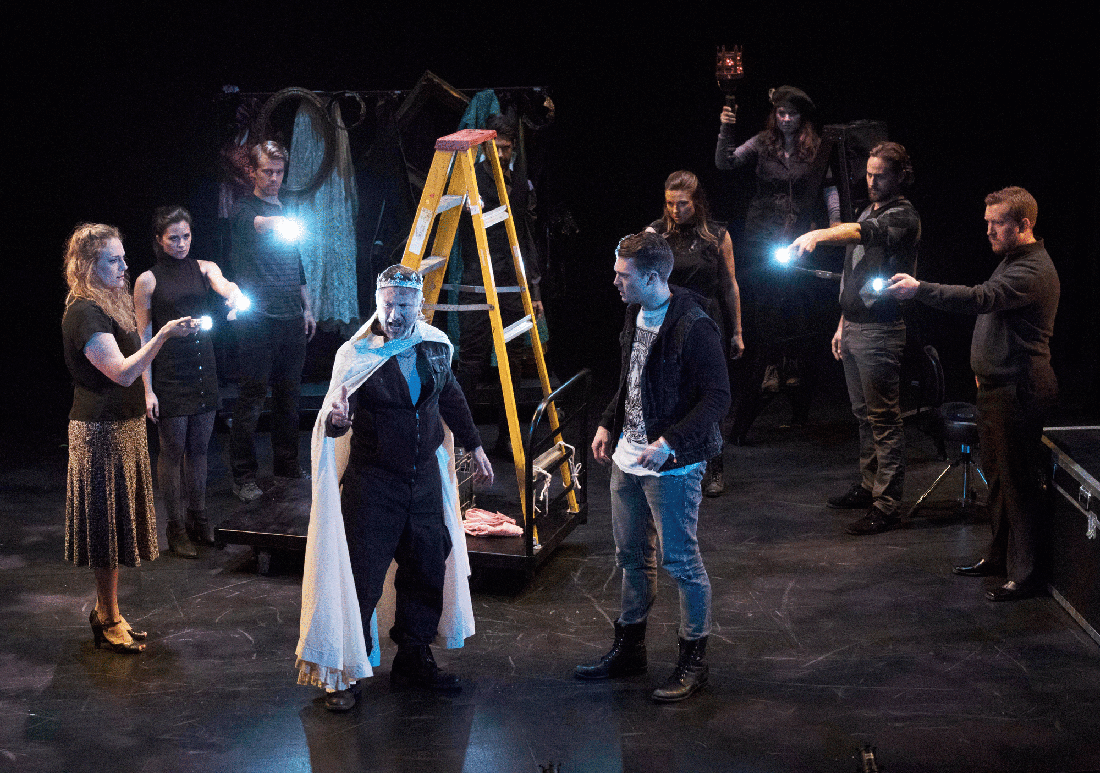- April 19, 2024
-
-
Loading

Loading

“The Tragedy of Hamlet” is coming to Carrie Mills’ classroom at Booker Middle School. Thanks to the school’s celebrated visual and performing arts program, it’s not a typical classroom — more like a small black-box theater with a stage at one end and rows of plastic chairs on the other.
The students filling those chairs aren’t typical, either. They’re excited, but not cutting up. A classroom of future arts professionals — and already thinking like professionals. They’re here to see a play. And also to see how it’s done.
The players are third-year student actors from the FSU/Asolo Conservatory. They make rapid-fire introductions. (Jillian Courtney, Scott Kuiper, Brett Mack, Wyatt McNeil, Danielle Renella, Jacob Sherburne, Kelly Elizabeth Smith and Jessie Taylor comprise today’s cast.) After that, Mills gives the middle school audience some liberating advice.
“At other live performances, someone may have told you not to talk, breathe or move,” she says. “That’s not what live theater is about. Your energy helps brings the play to life. So if it’s funny, laugh. If it’s sad, feel free to cry. Just save your conversations until the play is over.”
With that, the actors jump into it. The ghost of Hamlet’s kingly father seems to fly in from the darkness. (The actor’s actually perched on top of a ladder being wheeled across the stage.) A simple effect, but it earns a gasp. And Hamlet’s cutting words to Ophelia earn ugly looks.
And on it goes. The pace is fast and furious — cut down to what Hollywood screenwriting manuals call “action beats.” The focus is on real action in the real world, not thoughts in the characters’ minds. What’s going on?
This is “Hamlet” unplugged, but not uncut. Strictly speaking, it’s “The Tragedy of Hamlet” — an adaptation/condensation created by director Justin Lucero. Today’s performance is just one stop on a tour to schools and performing arts venues across the state.
Although a previous performance of the adaptation at the FSU Center for the Performing Arts got a good response, the students’ reaction took it to another level. The students relate to the play with their whole being. It’s all new and fresh to them. Some are meeting Hamlet for the first time — along with his friends and enemies. Those who’ve met the Prince before haven’t had time to be jaded.
Character is what they care about. Their empathy for the play’s poor souls fills the room. As Mills had told me earlier, their fascination goes beyond the technical nuts and bolts of live theater.
“These kids are immersed in the arts all day,” she says. “They’re interested in how the art is made. But they’re much more interested in what it means.”
The students’ deep sympathies don’t mean they can’t enjoy a good swordfight. Right now, Hamlet is driving Laertes across the room with a blistering series of swipes and thrusts. Decision: Hamlet. But he’s just turned his back on an angry man with a poisoned blade …
In an earlier phone interview, Justin had shared the intentions behind his adaptation. Before hebecame an edgy young director, he’d been an edgy young educator. On this project, he served two masters: art and education. He didn’t take that lightly.
“Adapting Shakespeare is a profound responsibility,” he says. “And ‘Hamlet’ is the holy of holies. I knew whatever I brought to the schools had to do justice to the essence of the play. I avoided artistic license and kept as much of the plot intact as possible, despite the drastic cuts. It’s a timeless story, so I wasn’t specific about where and when it happens.”
How did he pull that off — in practical terms?
Lucero hit on the concept of a traveling troupe of actors. The ragtag company honors Hamlet’s last words to his friend Horatio: “Tell my story.” Led by Horatio, they take Hamlet’s story on the road and stage the play with the typical backstage clutter you’d find at most theaters: a ladder, a hand truck, a costume rack — whatever they could find.
“The adaptation’s meant to seem incomplete and on the fly,” says Lucero. “It’s not a substitute for the original; it’s a doorway into it. There are gaps and mysteries and deeper levels to explore. When the students leave, I want them filled with questions and hungry for more.”
Right now, Queen Gertrude just sipped from the poisoned chalice King Claudius meant for Hamlet. (This earns yet another gasp, seemingly from students who want to go back in time and stop her.) Thanks to Laertes’ poisoned blade, Hamlet’s already a walking dead man. Laertes points this out. Hamlet knows exactly where the blade should go next.
“Then venom to thy work!”
And he runs King Claudius through in a nice bit of fight choreography. (Kudos to Dan Granke.)
The rest is silence.
After the silence, crashing waves of applause. The actors bow, clearly moved. Now the students can talk.
Why is Hamlet wearing an edgy, modern T-shirt, when the other actors look old-fashioned? Does that mean he’s ahead of his time?
Did the Queen drink the poison on purpose, or by mistake?
Why did Horatio see the Ghost but not Hamlet’s mother?
Why do the actors in the play-within-a-play wear masks?
Lucero wanted to leave students filled with questions.
That’s exactly what he did.